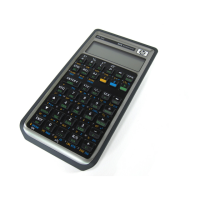In addressing, progress is recorded as explained in the tables above in detail. You
may cancel such pending operations by as described below.
5. In programming mode, the numeric display indicates the program step (000 505)
in the mantissa and the number of free steps in the exponent, while the dot matrix
shows the command contained in the respective step, e.g.:
6. For floating point decimal numbers, the mantissa will be displayed adjusted to the
right, the exponent to the left. Within the mantissa, either points or commas may be
selected as radix marks
17
, and additional marks may be chosen to separate thou-
sands. Assume the display set to FIX 4, then 12.345678901 millions may look like:
or
with thousands separators on, and without them like:
or
These separators may also be beneficial in integer or fraction modes described be-
low. With ENG 3 and after changing the sign, the same number will look like this:
or
If the last operation executed was a complex one, a capital C is displayed top left in
the dot matrix pointing to the fact that you find the result of this function in X and Y.
Floating point decimal numbers within
may be entered easily.
Using a decimal mantissa, even numbers down to 10
394
can be keyed in. The calcu-
lator works with numbers down to 10
398
correctly. Smaller values are set to zero.
For results
, error 4 or 5 will appear (see below).
7. In integer modes, numbers are displayed adjusted to the right as well. Word size
and complement setting are indicated in the dot matrix using a format xx.ww, with xx
being 1c or 2c respectively, un for unsigned, or sm for
sign-and-mantissa mode. Sign and first
the second third an overflow. Integer bases
are indicated as follows:
17
Starting here, decimal input is written using a point as radix mark throughout this manual, although sig-
capable to read radix points and interpret them correctly than vice versa.

